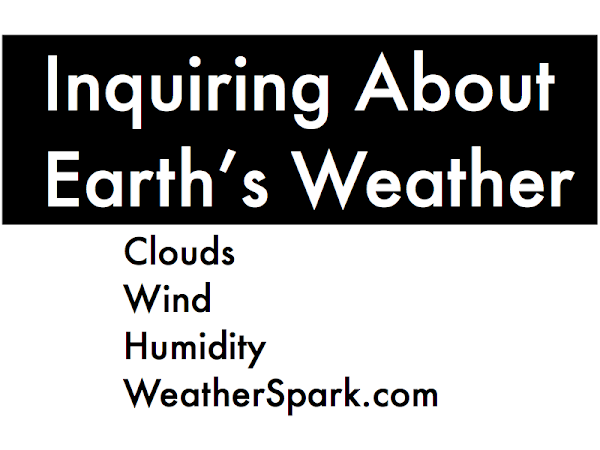 (This is the sixth Astronomy 210L laboratory at Cuesta College, San Luis Obispo, CA. This course is a one-semester, optional adjunct laboratory to the Astronomy 210 introductory astronomy lecture, taken primarily by students to satisfy their general education science transfer requirement.)
(This is the sixth Astronomy 210L laboratory at Cuesta College, San Luis Obispo, CA. This course is a one-semester, optional adjunct laboratory to the Astronomy 210 introductory astronomy lecture, taken primarily by students to satisfy their general education science transfer requirement.)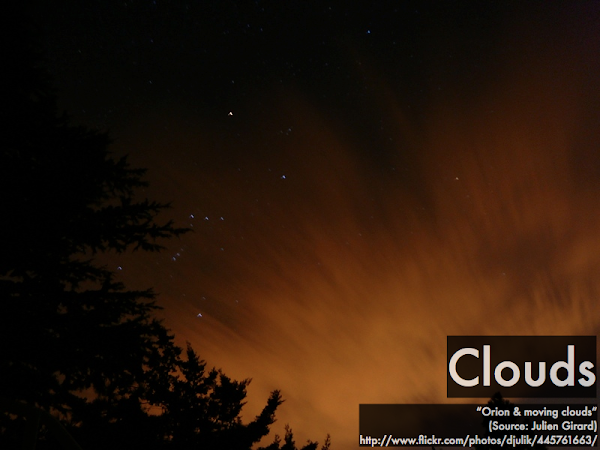 Cloud cover is not the only weather-related nemesis of astronomers.
Cloud cover is not the only weather-related nemesis of astronomers.The wind can be problematic as well, since we are observing at the bottom of an ocean of air. (Video link: "D90 HD Test 3.")
Any turbulence that stirs up the atmosphere will affect seeing, and cause distortions in telescope images (as well as twinkling the stars). (Video link: "Atmospheric Distortions.")
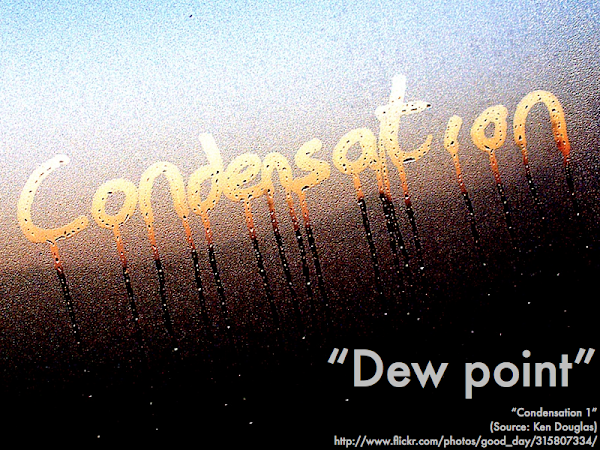 And even if the skies were clear and still, astronomers have one more weather-related pitfall: condensation forming on their telescopes. This happens when the air temperature falls below the dew point, where it becomes too cold for for water molecules to be suspended in the air, and they begin to glom onto each other and collect on cold surfaces. In order to prevent this, astronomers may resort to use heaters to warm up their telescopes if the temperature falls below the dew point, but while this will keep the telescope dry, it may also warm up the surrounding air and distort seeing.
And even if the skies were clear and still, astronomers have one more weather-related pitfall: condensation forming on their telescopes. This happens when the air temperature falls below the dew point, where it becomes too cold for for water molecules to be suspended in the air, and they begin to glom onto each other and collect on cold surfaces. In order to prevent this, astronomers may resort to use heaters to warm up their telescopes if the temperature falls below the dew point, but while this will keep the telescope dry, it may also warm up the surrounding air and distort seeing. Today you'll investigate not only the weather forecasts on the WeatherSpark website (weatherspark.com), but also gather data from historical weather records as well.
Today you'll investigate not only the weather forecasts on the WeatherSpark website (weatherspark.com), but also gather data from historical weather records as well.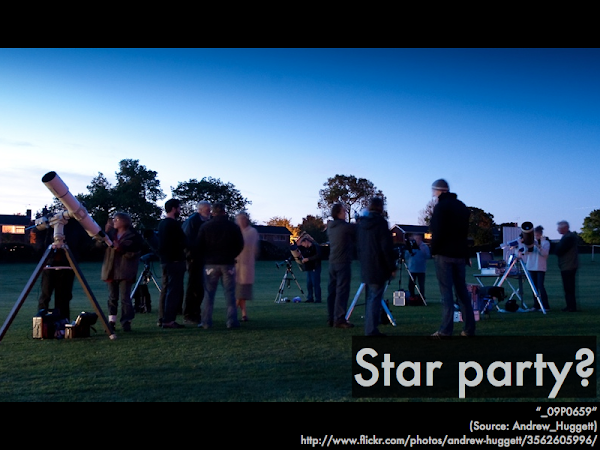 So next time you ever get to plan a star party...
So next time you ever get to plan a star party...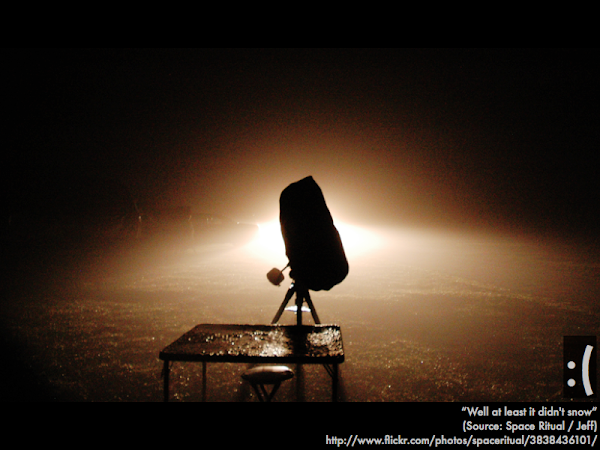 Heed the weather reports!
Heed the weather reports!Unless you operate radio telescopes, which are for the most part not affected by cloud cover, turbulence, or the dew point.
TASKS (as per Slater, Slater, Lyons, 2010, with the following modifications)
Computer Setup
Access the WeatherSpark website for your campus by clicking on the appropriate link below:
*Main campus, San Luis Obispo, CA (*.html)
*North County campus, Paso Robles, CA (*.html)
On the left side of the top menu bar, make sure the "Dashboard" button is selected/highlighted in the "Forecasts-Dashboard-Averages-More" options. On the upper right corner, under "Forecast:" click on "NOAA" and select "NOAA - NOAA's National Weather Service (USA only)." Then click on "Graphs," and then make sure that the following options are checked:
*Icons
*Sun & Moon
*Clouds
*Precipitation Probability
*Precipitation Amount
*Temperature
> Temperature Options
*Show dew point
*Show icons
*Dew Point
*Wind Speed
Clicking on "Daily," "1 quarter," or "1 year" will expand or contract the horizontal time scale. Trackpad or mouse wheel scrolling may also change the horizontal time scale as well. (You may elect to hide the map on the left side of the screen by clicking on the "<" button, in order to maximize the view of the graphs on the right hand side of the screen.)
3. What Conclusions Can You Draw From This Evidence? Wind is caused when air rapidly moves from one place to another. Typically best telescope viewing is done when the air is calm, to minimize "twinkling" from atmospheric turbulence. What conclusions and generalizations can you make from the following data collected by a student in terms of "What season of the year (in 2009) was best suited for telescope viewing in San Luis Obispo, CA?" by analyzing which season (winter, spring, summer, or fall) has the greatest or least peak wind speed, and most or least number of weeks with more than 50% cloud cover.
Explain your reasoning and provide specific evidence, with sketches if necessary, to support your reasoning(*).
4. What Evidence Do You Need to Pursue?
Condensation is a common problem for telescopes:
Describe precisely what evidence you would need to collect and how to collect it in order to answer the research question of, "If a robotic telescope were to make continuous observations tonight, from one hour after sunset to one hour before sunrise tomorrow, what time(s) should the dew warmer be programmed to run?" (Running the dew warmer continuously all night may needlessly create local thermal drafts that would affect viewing.) You do not need to actually complete the steps in the procedure you are writing. (For the purposes of this activity, assume that the sky will be clear tonight for observations.)
Create a detailed, step-by-step description of evidence that needs to be collected and a complete explanation of how this could be done--not just "look up the dew point forecast," but exactly what would someone need to do, step-by-step, to accomplish this. You might include a table and sketches--the goal is to be precise and detailed enough that someone else could follow your procedure.
Reference:
| Month (2009): | Peak Wind Speed (mph): | Weeks w/More than 50% Cloud Cover: | |
| Jan | 5.6 | 1.0 | |
| Feb | 6.7 | 1.5 | |
| Mar | 8.9 | 0.5 | |
| Apr | 11.0 | 1.0 | |
| May | 12.3 | 3.0 | |
| Jun | 7.8 | 1.0 | |
| Jul | 7.6 | 1.0 | |
| Aug | 9.2 | 1.0 | |
| Sep | 6.9 | 0.0 | |
| Oct | 7.4 | 1.0 | |
| Nov | 5.4 | 1.0 | |
| Dec | 5.4 | 1.0 |
Explain your reasoning and provide specific evidence, with sketches if necessary, to support your reasoning(*).
4. What Evidence Do You Need to Pursue?
Condensation is a common problem for telescopes:
You're out with your telescope on a pleasant summer evening, up late... You notice something strange. The dim stars begin to fade. The images of the bright stars suddenly have ghostly white haloes. And finally, you can barely see anything at all.The dew point is the temperature at which condensation starts to accumulate due to humidity. If the temperature of your telescope (approximately the same as the ambient air temperature) falls below the dew point, condensation will begin; if the temperature is above the dew point, no condensation forms. One method to actively prevent condensation is to use built-in electric warmers to keep the telescope temperature above the dew point. A dew warmer may affect observations by creating warm air updrafts, so a dew warmer should only be turned on when necessary.
The stars are gone.
You look at the sky. Have clouds rolled in? No. All clear.
Then, you take a peak [sic] at the lens of your telescope. A thick layer of water--dew--has condensed on your lens.
You don't dare wipe the dew off the lens for fear of damaging the soft anti-reflection coatings. And with no other way to remove the coating of water, your idyllic observing session has come to an early end. All you can do is pack up and go home, with your ambitious observing plan left undone.
What happened?
Condensation. The temperature of your telescope's lens fell below the so-called "dew point." And just as when you take a bottle of cold beer out the fridge, a swarm of water molecules from the surrounding air condensed onto the glass like locusts on a field of wheat.
--One Minute Astronomer Blog, "Don't 'Dew' This With Your Telescope...," April 29, 2010 (*.html)
Describe precisely what evidence you would need to collect and how to collect it in order to answer the research question of, "If a robotic telescope were to make continuous observations tonight, from one hour after sunset to one hour before sunrise tomorrow, what time(s) should the dew warmer be programmed to run?" (Running the dew warmer continuously all night may needlessly create local thermal drafts that would affect viewing.) You do not need to actually complete the steps in the procedure you are writing. (For the purposes of this activity, assume that the sky will be clear tonight for observations.)
Create a detailed, step-by-step description of evidence that needs to be collected and a complete explanation of how this could be done--not just "look up the dew point forecast," but exactly what would someone need to do, step-by-step, to accomplish this. You might include a table and sketches--the goal is to be precise and detailed enough that someone else could follow your procedure.
Reference:
- Tim Slater, Stephanie Slater, Daniel J. Lyons, Engaging in Astronomical Inquiry, W.H. Freeman & Company, New York, 2010, pp. 33-37,
http://www.whfreeman.com/newcatalog.aspx?disc=Astronomy+%26+Physics&course=Introduction+to+Astronomy&isbn=1429258608.




2 comments:
Astronomy 210L, Spring Semester 2011
Cuesta College, San Luis Obispo, CA
Online post-lab assignment 5
Discuss the most interesting aspect of this lab, and explain why this was personally interesting for you.
The following are a sampling of the student responses to this question, verbatim and unedited.
"I found that it was interesting to compare the weather to different years in the past
determining weather patterns throughout the year."
"Looking at the month-by-month breakdown of the weather data was the most interesting."
"Seeing how consistent weather patterns are year to year"
"Discovering how weather patterns can interfere with observations"
"It was interesting to me that average wind speed doesn't change that much month to month."
"it was interesting to learn that the weather is similar on specific dates each year"
"Finding out what causes stars to twinkle."
"It was really neat to use wunderground.com. I've since used it for upcoming travel plans to get weather averages."
"Finding out how much the temperature changed on the same day, but different years."
"Learning how the weather affects astronomical conditions."
"This lab was interesting because I never thought about the dew point affecting a telescope.
It was interesting to learn that this past Monday was the coldest one SLO has had in a while."
"I thought seeing the differences in the weather between years was interesting. It's just interesting to see change."
"The most interesting part of this lab was comparing the weather today compared with the weather on the same date last year and then year before, etc. It was interesting to see the changes throughout the years"
"I enjoyed looking up all the historical weather data for this area, finding out records and averages. I didn't know a telescope could get condensation."
"I thought learning about the weather and how it affects star gazing was the most interesting aspect."
"Personally, didn't find this lab very interesting. It was straightforward and simple. Not a lot of jawdropping moments"
"i liked the weather aspect. it was cool to see some of the limitations on astronomy"
"I thought it was interesting to see the difference in the weather and determining what months would be best to examine the sky."
"I liked switching the days and seeing the diffrence in the weather."
"it was interesting to note dew point and learn about the telescope warmers"
"The question we asked, we ended up getting some very interesting results"
"It was interesting looking up old weather conditions from years and years ago"
"the most interesting was looking back 21 years and seeing no difference"
"i liked messing with the dates on the website."
Astronomy 210L, Spring Semester 2011
Cuesta College, San Luis Obispo, CA
Online post-lab assignment 5
Discuss the most confusing aspect of this lab, and explain why this was personally confusing for you.
The following are a sampling of the student responses to this question, verbatim and unedited.
"The only thing I found confusing was trying to determine what month had the worst viewing conditions, and weighing whether wind speed or precipitation levels are more important to viewing conditions."
"Just gathering all of the proper information, and describing the graphs"
"how gust speed influences star viewing."
"seeing the correlation between weather and telescope viewing"
"This lab by far the most enjoyable and I didn't find it confusing."
"The barometric pressure was confusing. Not finding it, but I'm still not sure what it is or what it does."
"what is more important, Average wind speed or Average gust speed?"
"This lab was more interesting than confusing."
"The lab was pretty simple, comparing data from different dates wasnt very confusing"
"I didn't understand what a some questions were asking but after they were explain it was a piece of cake."
"This wasent really confusing but I just don't like drawing graphs:"
"There was no dew points for the days that we reseached, but there was dew. It was cleared up, no longer confusing."
"ummm trying to come with a relevant research question."
"Collecting step by step procedures for another person."
"The Research Question"
"Coming up with a research question was confusing because there really isnt that much to say about this project. Like two people could explain all of it almost."
"Why these things change"
"was writing the weather description"
"Coming up with a question to answer cuz im not creative."
"i liked messing with the dates on the website."
Post a Comment